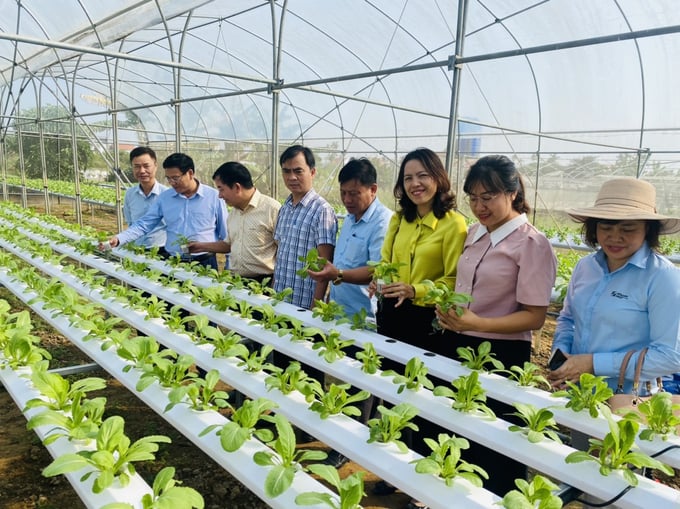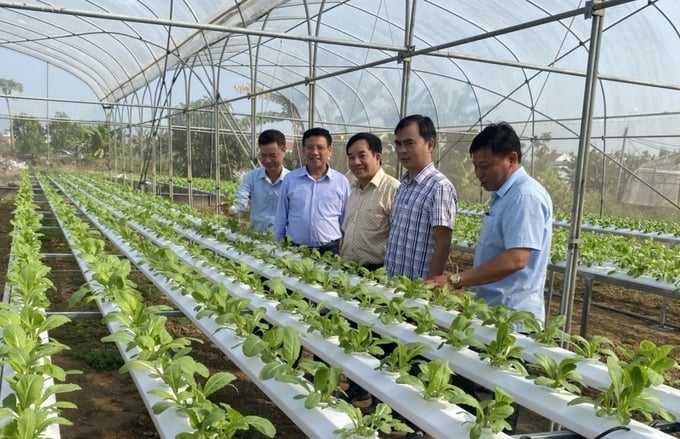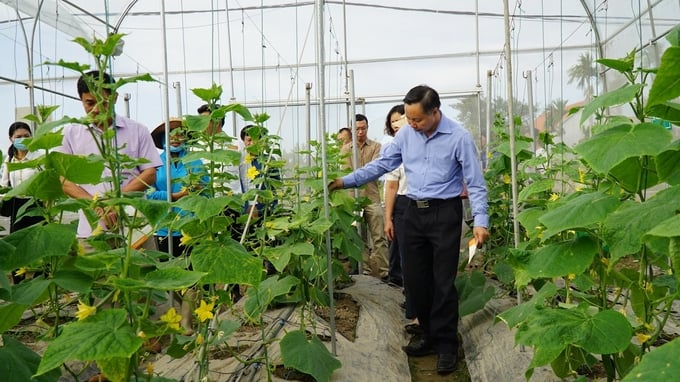June 2, 2025 | 02:30 GMT +7
June 2, 2025 | 02:30 GMT +7
Hotline: 0913.378.918
June 2, 2025 | 02:30 GMT +7
Hotline: 0913.378.918

The leadership of Hai Phong city's Department of Agriculture and Rural Development conducting an inspection of the hydroponic vegetable farming model. Photo: Dinh Muoi.
Thai Son Livestock Services Cooperative in Kien Thuy district, Hai Phong city, stands as a pioneering force in fostering collaborative efforts within the fields of livestock production, aquaculture, and crop production over the past few years, thereby raising the income levels of its members.
Established in 2016, the cooperative primarily engages in livestock production, aquaculture, and organic vegetable farming. However, after recognizing the adverse impacts of diseases on pig farming in 2018, the cooperative made a strategic shift towards investing in vegetable farming.
With a significant capital injection, the cooperative began by constructing an 1-hectare greenhouse for clean vegetable production. Subsequently, the cooperative focused on producing seasonal leafy vegetables such as water spinach, vine spinach, sweet leaf, cabbage, kohlrabi, cucumbers, etc.; and supplying them to schools, supermarkets, and businesses.
Despite initial success, the cooperative's quantity and variety of products remained relatively low due to the fragmented production of small-scale livestock farmers predominantly operating as farming households, and the limited number of large-scale commodity production models. Moreover, the substantial initial investment costs translate into higher market prices for the vegetables, thereby limiting marketing and distribution efforts.

Experts are pleased with the effectiveness of the model. Photo: Dinh Muoi.
In response to these challenges, Ms. Dong Thi Doanh, Director of Thai Son Livestock Services Cooperative, pioneered the implementation of a safe hydroponic leafy vegetable farming model. This initiative was supported by Hai Phong city's Agricultural Extension Center.
Hai Phong city's Agricultural Extension Center initially launched a trial project covering an area of 1,000 square meters, conducted within a greenhouse. Local farming households were provided with 40% of the necessary materials for the installation of the hydroponic system, which includes a frame, control pumps, pH meters, nutrient solutions, pumping and water recovery systems, among others.
The model incorporates an automatic pumping system to deliver nutrient solutions directly to the vegetable roots through a drip irrigation process, ensuring a slow and continuous supply of water. Subsequently, excess nutrients are filtered back into the reservoir for reuse, thereby reducing the labor, material, and operational costs associated with maintenance.
In addition to technology transfer, Hai Phong city's Agricultural Extension Center organized training programs to provide technical guidance on the cultivation, care, harvesting, processing, and packaging of products for delivery to local supermarkets and clean vegetable distributors.
After six months of implementation, various types of leafy vegetables have been introduced into the farming model, including leaf mustard, bok choy, lettuce, trimmed lettuce, amarant, water spinach, and so on.

The model maintains optimal conditions for the growth and development of safe, high-quality vegetables and fruits. Photo: Dinh Muoi.
Ms. Dong Thi Doanh revealed that with a growth cycle ranging from 25 to 35 days, the model yields between 33 and 48 tons of vegetable per 1,000 square meters. These vegetables fetch prices ranging from 25,000 to 45,000 Vietnamese dong per kilogram at AEON MALL supermarkets. Accordingly, the model's profits are 1.5 times higher than that of conventional greenhouse farming.
"I initially found production to be quite challenging; however, with technical guidance from the city's Agricultural Extension Center, I gradually adapted. Now, I find the process to be relatively straightforward, and the economic efficiency is significantly higher than that of traditional farming methods. I look forward to expanding the model further as we secure additional outlets," Ms. Doanh shared.
According to Dr. Vu Duc Hanh from the Hai Phong city's Agricultural Extension Center, the hydroponic farming model involves cultivating plants in nutrient solutions, commonly referred to as water culture or soilless cultivation. In this farming model, plants are grown on inert media and directly absorb nutrient solutions to facilitate growth and development. This approach is space-efficient and can utilize small, elevated spaces such as rooftops, balconies, or small gardens.
"Vegetables in this farming model follow a seasonal production cycle, which increases the yield and minimizes the impact of external environmental factors. The model also minimizes the presence of harmful organisms, and reduces the need for unnecessary plant protection chemicals, thereby enhancing the safety and quality of the produce," Dr. Hanh elaborated.
The key advantage of the hydroponic vegetable farming model lies in the safety of its product, which is the result of a water-based cultivation environment. Additionally, precise control over nutrient solutions, as well as daily monitoring and proactive adjustments of pH and EC levels create optimal environmental conditions and abundant nutrient supply for the vegetables, without the risk of residual chemical compounds in the final product.
Translated by Nguyen Hai Long

(VAN) Several scientists and farmers are experimenting with soil treatment in some key durian-growing regions such as Cai Lay (Tien Giang), Dak Song, Gia Nghia, and Dak R’lap (Dak Nong).
/2025/05/25/4127-3-073637_820.jpg)
(VAN) Thanks to the promotion from an FAO-implemented project, vegetable production in greenhouses in Moc Chau has seen strong development, from 1.5 hectares in 2021 to nearly 50 hectares in 2024.

(VAN) FAO has recently supported USD 140,000 to implement the project 'Risk mitigation human-animal interface risks through disease control initiatives in pig farming.'

(VAN) The People's Committee of Tra Vinh province has approved an adjustment to the investment policy for the Green Hydrogen Plant project, increasing its area to approximately 52.76 hectares.
![Reducing emissions from rice fields: [2] Farmers’ commitment to the soil](https://t.ex-cdn.com/nongnghiepmoitruong.vn/608w/files/news/2025/05/05/dsc08881jpg-nongnghiep-140632.jpg)
(VAN) Clean rice cultivation model in Thuong Tan commune, Bac Tan Uyen district, is assisting local residents in achieving sustainable agriculture by substantially reducing costs, increasing productivity, and protecting the environment.

(VAN) At the conference to disseminate Resolution No. 68, AgriS introduced its digital agricultural ecosystem and reaffirmed its commitment to accompanying the Government in promoting private sector development and sustainable agriculture.

(VAN) 'Blue Ocean - Blue Foods' initiative is designed to restore marine ecosystems and establish sustainable livelihoods for local communities by cultivating a minimum of 1,000 hectares of cottonii seaweed in the first three years.